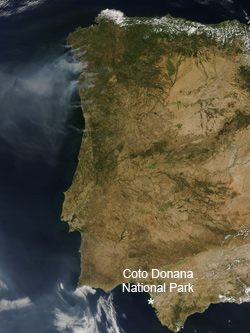Education key to financial support for biodiversity
Education key to financial support for biodiversity
Jeremy Hance, mongabay.com
September 6, 2007
On the coast of south-western Spain, Coto Donana National Park posses a unique wealth of wildlife; its proximity to Africa has allowed for several African species to mix with a wide variety of European: Egyptian Mongooses and the Greater Flamingo live alongside wild boar and Spanish Red Deer. The coastal and wetland park provides a continual respite for hundreds of species of African and European birds. As well, the park is home to several endangered species including the Spanish Imperial Eagle, the Andalusian toothcarp, the Sabine (a variety of juniper pine), and the world’s most endangered cat, the Iberian Lynx.
It was in this one-of-a-kind park that scientists Berta Martin-Lopez, Carlos Montes, and Javier Benayas undertook a study on how the public responds to conservation efforts: specifically, what is the general public willing to pay for the conservation of wild spaces and the preservation of species? Participants were asked whether or not they would pay an annual amount into an imagined Trust Fund to protect Coto Donana National Park and its inhabitants. Their findings concluded that the higher educated the subject the more likely they would be to donate and to give their money to species based on scientific reasons such as threat level, importance in ecosystem, and uniqueness in region.
 Image courtesy of NASA |
Twenty-seven percent of the subjects interviewed stated they would not give any money. The remaining seventy-three percent who expressed a willingness to donate to Coto Donana National Park were asked to select five species out of fifteen to spend their money on. In total the first four spots went to charismatic mammals and birds, two of which are not endangered. Next came two tree species, an alien turtle species (but popular as a pet) and an endangered carp. Moss and Common Frogbit, both vital plants for the ecosystem, came in at number nine and ten respectively. Species that attract few admirers: bats, snakes, and spiders appeared at eleven, twelve, and fourteen respectively, even though all of the chosen species are endemic to Coto Donana National Park. Finally, microscopic organisms rounded out the end, despite the fact that they are vital to the ecosystem. As one of the scientists, Berta Martín-López, working on the study states: “The low values associated to species with high ecological and scientific values, such as reptiles or invertebrates, raises the necessity of more education efforts to make people aware of the importance of these species”.
The study also illustrated how different groups of visitors displayed different tendencies in selecting species. Those who came to the park for a day visit or to use the beach primarily chose species that were familiar or useful to humans, i.e. for pets or recreational activities like bird-watching. Those who visited with the purpose to have a natural experience chose mostly charismatic and attractive species. Finally, environmental professionals of Coto Donana National Park selected species based on endangerment status, ecological role, and uniqueness to the environment. Furthermore, it was found that visitors with higher educations tended to choose species based on more scientific considerations, i.e. on threat-level and importance in ecosystem. Younger visitors did the same, perhaps because the younger generations have had more access to scientific and environmental information and so attach greater value to environmental conservation.
Overall the study indicates that for now it is the charismatic, larger species that still bring public funding and support. Yet with more education and information people are willing to change their inclination towards megafauna and flora and put funds where they are most needed, to save species on the brink and to keep environments healthy by protecting those species most useful in the ecosystem. More and better education in science and biology could make a large difference in the public’s desire to participate in conservation and their willingness to pay a price to make that happen. Mr. Martin-Lopez, who is currently working on the study that looks at the same questions globally, states, “environmental education including scientific information is one of the most important conservation actions”. But as it stands, many important and endangered species are left without protection simply because they are not big mammals, impressive birds, or towering trees.
CITATION: Berta Martín-López, Carlos Montes and Javier Benayas (2007). The non-economic motives behind the willingness to pay for biodiversity conservation. Biological Conservation Volume 139, Issues 1-2, September 2007, Pages 67-82













